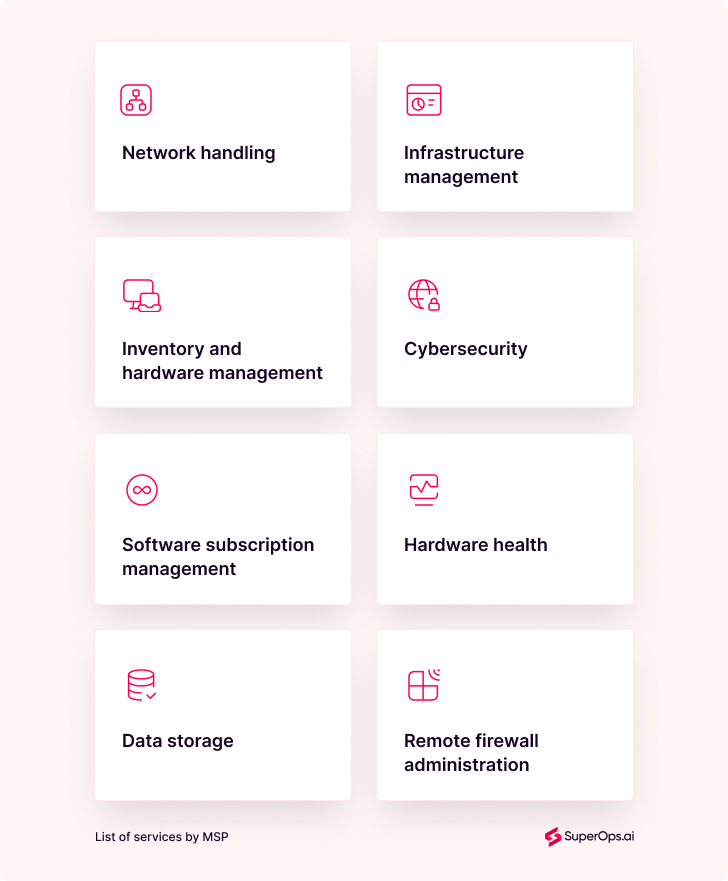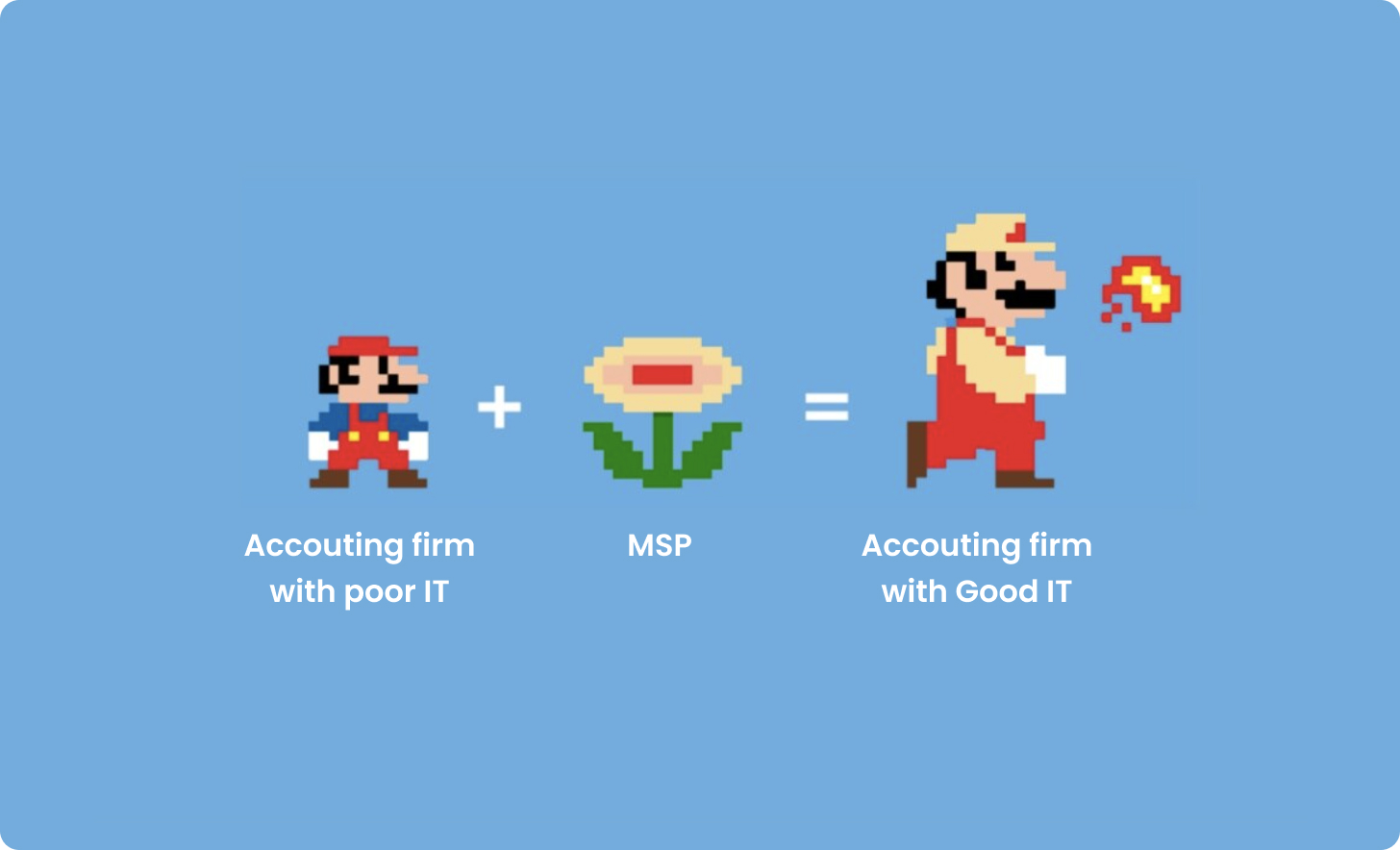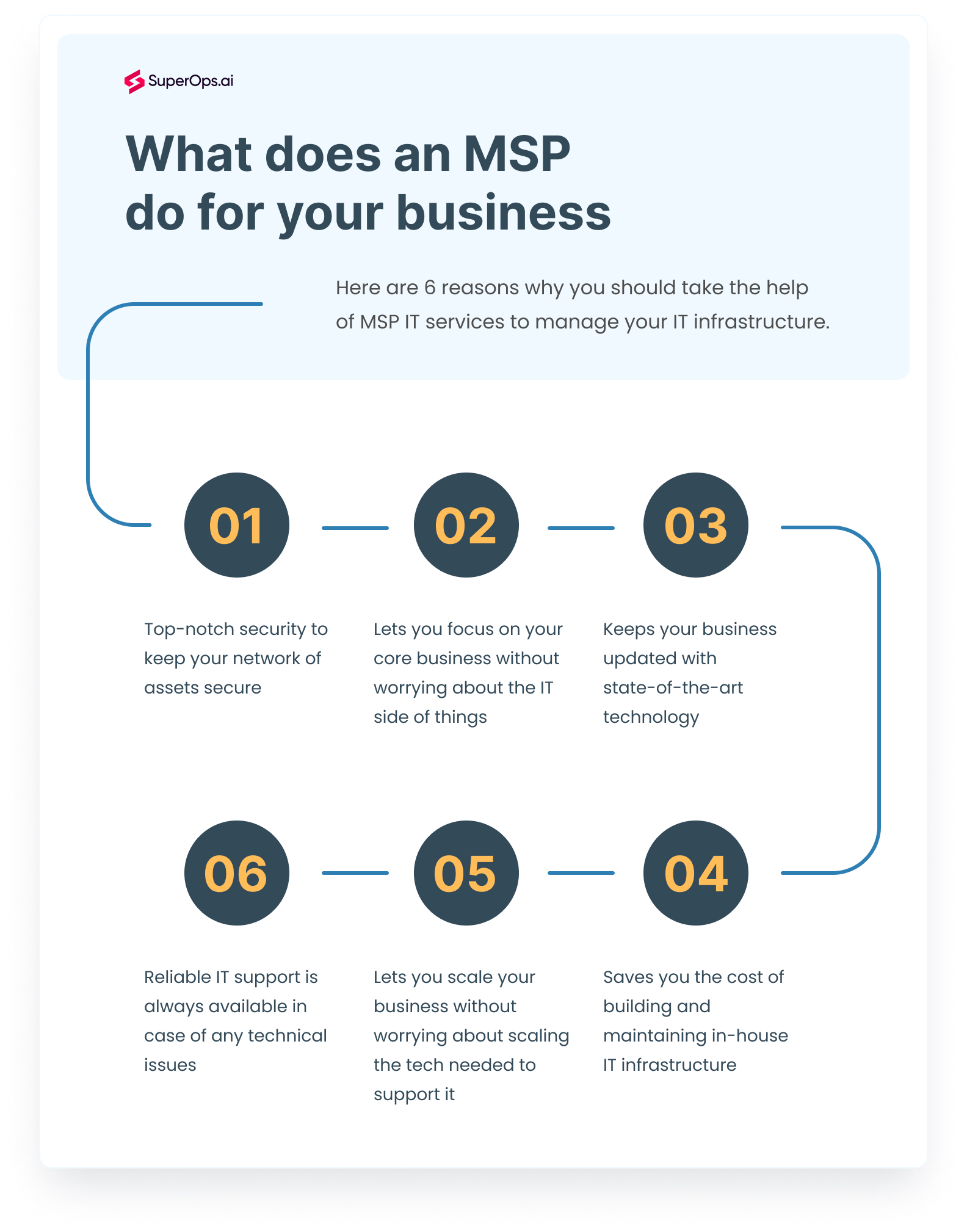What is an MSP?
Anyone who’s new to the MSP market will have a hard time understanding the broad concept that MSP is. But what’s managed services anyway? Who are MSPs? How are MSP and break-fix different? Let us clear the air. Read the complete guide to managed services we’ve put together for you.
Evolution of MSPs
Before we start talking about MSPs, their importance in your business’s lifecycle, it’s important we understand their evolution. Were MSPs existent from the time of Adam and Eve? What did the world look like before Managed Service Providers came into existence?
The emergence of managed service providers (MSPs) was supported by the beginning of application service providers (ASPs) in the 1990s that paved the way for remote application hosting. In practice, any organization that provides services to its customers in the areas of IT infrastructure and end-user systems maintenance, and operation from a remote location is referred to as an MSP.
ASPs led to the evolution of cloud computing services and the establishment of organizations that would exclusively provide remote support to clients and their information technology infrastructure.
In the beginning, managed service providers were centred on remote monitoring and management (RMM). With time, they broadened their services to include service-based models to distinguish themselves from other MSPs.
So, how does an MSP function? What do people who run an MSP do?
What is an MSP?
An MSP is a third-party firm that administers the information technology (IT) infrastructure and maintains end-user systems for a client. There is a definitive set of day-to-day activities that are contracted out to managed service providers (MSPs) by small and medium-sized enterprises (SMBs), nonprofits, and government bodies. Network handling and infrastructure management, ongoing maintenance, security, and supervision are part of an MSP's services.
List of services offered by MSPs
The management services provided by MSPs are frequently performed on a regular basis, allowing companies to focus on effectively improving their core services rather than worrying about needless system outages or discrepancies in services. The majority of the time, the MSP service leverages a subscription model — undertaken proactively for MSP outsourcing. |  |
However, although some managed service providers (MSPs) may specialize in specific parts of IT like data storage, others may be focussed on vertical markets that include the legal, financial, healthcare, or industrial fronts. For instance, managed security service providers specialize in specific services like remote firewall administration as well as other diverse solutions such as security as a service. Managed print service companies are responsible for the upkeep and supply of printers and consumables.
Looking to start an MSP? We have got you covered. |
MSPs, VARs, Break-Fix shops- What’s the difference?
As with every vertical, MSPs come in various shapes and sizes. Here’s a list of service providers, based on how they operate:
Practice | MSPs | VARs | Break-Fix shops |
Client contracts | Have a contract with clients that guides the level of their service | There are contracts in place between VARs and the developers of a product | Break-fix shops are not bound by contracts |
Selling a product | Sell both IT services and products | Make enhancements to existing products, services to cater to specific verticals and sell them | Don’t generally sell products |
Managing your IT | MSPs take total care of the IT needs of clients | Provides specialized IT support for clients based on domain expertise | Doesn’t manage IT on a day-to-day basis; intervenes only when the client is experiencing issues |
In comparison to other channel organizations such as value-added resellers (VARs), managed service providers have a distinct business model. Managed Service Providers use different pricing options to price their clients for their services. These billing arrangements can be based on per-device or per-user criteria. It can even include an all-inclusive pricing model.
Small and medium-sized businesses (SMBs) are now well-informed about the cost advantages of outsourcing, in addition to the technical competence. In contrast, hiring an in-house IT team is far more expensive.
On the other hand, instead of relying on a single specialist, they have an entire team to assist them with their technological matters. They provide you with: skilled and trained IT professionals, as well as the following products and services:
Companies that have benefited from managed services providers (MSPs) have seen immediate benefits, reduced instances of failures, improved staff productivity, a significant decrease in IT support expenses, and enhanced profitability.
Shifting from break-fix and looking for a PSA and RMM? |
How does an MSP work?
An MSP operates by onboarding different enterprises, usually small to medium businesses, as clients. Since they lack an in-house IT staff, they rely on an MSP to bridge the gap in their IT infrastructure and ensure business continuity. The MSP is then responsible for the maintenance and servicing of these enterprises' information systems.
Take a modest-sized accounting firm, for instance, which is required to handle their customers' day-to-day financial statements and maintain a centralized digital record to keep confidential data secure and easily accessible. In addition to this, they are also expected to keep their IT infrastructure functioning without disruptions so accounting applications are up and running around the clock. It can be daunting to supervise storage and maintenance tasks with core business activities on the line.
In such a case, the accounting firm can consider hiring an MSP that will undertake the needful responsibilities including storing financial data securely in a centralized server and simultaneously providing tech support on the business site as and when required.

How do MSPs make revenue?
The subscription model is the second most popular form of service business. On a monthly basis, businesses compensate an MSP with a regular charge to provide IT services.
If something goes wrong while clients are in the subscription period, the MSP will send a technician to fix it without charging a fee to the customer because the company's subscription fee covers the repair cost. Payment plans for this type are often structured around per-hour rates per device or break-fix contracts.
The MSP also concentrates on the deployment of specialized software tools that automate various functions. These platforms are made up of remote monitoring and management (RMM) applications and professional services automation (PSA) tools:
RMM allows MSPs to maintain networks, end-user systems, servers, and mobile devices using remote management and monitoring software. Additionally, MSPs can leverage these tools to apply patches, run scripts, and install system updates to their clients' computers.
PSA solutions enable managed service providers to supervise a company's projects, handle accounts, and take charge of assets and inventories.
Here are brief insights into RMM and PSA
RMM
RMM tools help MSPs troubleshoot and monitor assets in the client’s network remotely. A good RMM solution helps MSPs have
Remote access and remote support
Patching and scripting
Asset management
Alert management
PSA
PSA or Professional Services Automation is a suite of tools that enables managed service providers to manage and respond to client requests in a single platform. A good PSA system offers contract management, ticket assignment, worklog management to track resource utilization, automation, and a good project management system to manage the MSP’s workflow. On top of this, PSAs also help them manage their client relationships effectively.
Most managed service providers (MSPs) must provide end-user assistance, which is why most PSAs incorporate helpdesk tools alongside team management applications. Such self-service systems should be included in these modules in order to reduce the need for human assistance.
In essence, a good PSA should contain the following modules
- Helpdesk
- Contracts
- Invoicing
- CRM
- An end-user interface to log tickets
- Reporting
- Project management
PSA is an important tool in an MSP’s tech stack but how important is it? Listen to Chris Timm on Why PSA is the most important tool in your tech stack
So, now that you know all about how MSPs operate- let’s address the BIG question.
Why does your business need an MSP?
Here are 6 reasons why you should take the help of MSP IT services to manage your IT infrastructure
- Security and compliance - Let’s admit it, none of us are experts with cybersecurity and compliance. Working with managed service providers ensures you have experts taking care of it and not worry about them going wrong.
- Focus on your business - As a business owner, your sole focus should be on getting your growth right. MSPs can provide good quality of service and your IT team can focus on improving business productivity and not fire-fight everyday issues.
- Expertise from Day-1 - We live in an era where new technology pops up every day. While you can train your internal IT teams to get all that knowledge, it’s a lot easier to just leave it to the experts. Why spend time on recruiting when you could be helping clients?
- Lower costs - Having an MSP to help with your IT needs is definitely more cost-efficient than having to recruit and train IT technicians to the ever-changing needs of your employees. Cost-saving is an important benefit of outsourcing IT to MSPs.
- Scale as you please - With an MSP, you’ll never have to worry about scaling your IT needs. There’s an MSP to solve for your needs, irrespective of whether you want to scale up (or down).
- Reliable support - Having an MSP is like having that 2 AM friend to help you out in case of an emergency. Most MSPs do offer 24*7 support

So, do you need an MSP? |
As with most things in life, it really depends. If you’re running a business that is technologically intensive, and requires a helping hand—definitely yes! If you feel IT is the weaker chink in your armour— then yes. If you think hiring an MSP is less expensive than hiring IT technician(s)- well, you know it by now! |
Frequently asked questions
We have them answered.
All your favorite tools, right here
No hunting around for tickets, assets, projects, IT documentation - manage it all with SuperOps






